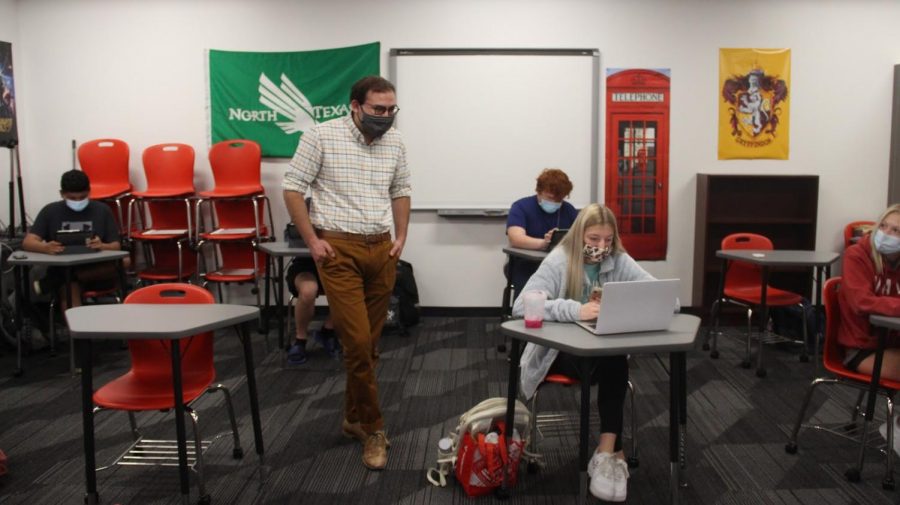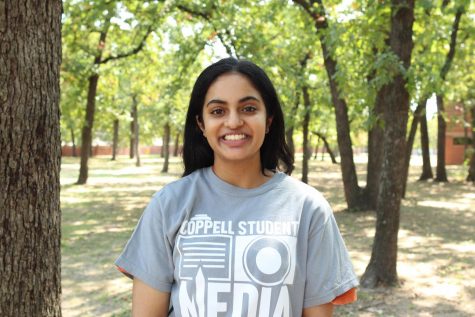DFW school districts prioritizing flexibility in pandemic schooling
Coppell High School English II teacher Stephen Patino assists CHS sophomore Macy Baume during fifth period in his classroom on Oct. 19. Due to COVID-19, schools in the Dallas-Fort Worth area have had to change their education system to manage COVID-19 cases.
December 17, 2020
In a bag in a closet in room E201 at Coppell High School, there lives a turquoise bowling ball. Each year, it is pushed back and forth by a broom as AP physics I students compete to maneuver the ball through an obstacle course. CHS AP physics I and II teacher Stephanie Sloane calls the game ‘inertia ball.’
This school year, the bowling ball sits undisturbed.
“I was really sad that we didn’t get to do inertia ball,” Sloane said. “We have a competition, everybody takes a turn and we’re trying to get through the [obstacle course] the fastest. Even to try to figure out how to do it at home, [not] everybody has something as massive [as a bowling ball].”
Assignments and activities such as these are absent from many lesson plans for the 2020-21 school year due to the lack of compatibility with a virtual platform.
Compatibility and equity are at the forefront of instruction this year in Coppell. Since Coppell ISD offers a hybrid learning model, offering both in-person or virtual education, administrators and teachers are working to find a way to make learning equal for both groups of students.
“There was real concern from some of our parents that if they didn’t send their kid in person, they wouldn’t get a high-quality education,” CISD Superintendent Dr. Brad Hunt said. “We wanted there to be equity so that if you’re in physics remote, you’re getting the same curriculum and high-quality [education] as a person who’s [taking physics in person].”
With equity as a goal, CISD coordinates its hybrid model so that both in-person and remote students attend the same Zoom class. However equitable the classes may be, unlike in-person students, motivation for remote students is mostly intrinsic, making it potentially more difficult for virtual students to stay on track.
CHS senior Emma Chambers attended school in person for about eight weeks and is now learning remotely.
“Virtually, it’s a lot easier to phone it in and go through the motions of finishing assignments,” Chambers said. “It’s a lot harder to stay motivated when you’re doing virtual school. There’s just something about being there with your teacher, knowing that there’s someone there who’s going to hold you accountable, that just forces you to have more responsibility.”
Because CISD has seen a majority of students choose to attend school virtually, a hybrid schedule was never fully considered.
But what about other districts in the Dallas-Fort Worth area? What about schools with a majority of in-person students?
These districts can employ more creativity to manage the spread of COVID-19 while still meeting the wishes of families to send their students in person.
Enter hybrid schedules.
Plano ISD groups together both remote and in-person students into either Cohort A or Cohort B. The schedule switches between asynchronous (students complete work on their own time) and synchronous (students attend classes and complete work in real-time). Each Cohort allows for two days of in-person synchronous (alternating between cohorts) and three days of virtual, asynchronous learning. Students who are not performing well academically can attend school in person four times per week.
Keller ISD, where 61 percent of students attend school in person, follows a similar structure to CISD, allowing virtual students to attend specific classes in person.
“Each instructional choice obviously has its challenges, whether they be the safety guidelines on campus or the reliance on technology and devices for our remote learners,” Keller ISD Director of Communications & Legislative Affairs Bryce Nieman said via email. “Like any other year, our teachers are focused on identifying where students may need additional support and working with them to achieve their academic goals.”
Communication between school districts about learning structures during the pandemic creates a network of information to promote a safe and productive learning system.
“We served as a resource for other districts and we also got great ideas from our neighboring districts [such as] Carroll, Carrollton-Farmers Branch, Lewisville, Plano, Prosper, Frisco [and more],” Hunt said. “Prosper ISD [had its first day of school] before us and they had more students in person, and one of the things their superintendent [Dr. Holly Ferguson] told me was that they didn’t track where kids were sitting at lunch. So, whenever there was an issue, they had a real hard time contact tracing. We learned from that, and it’s why most schools do a QR code or ask students to take a picture of where they’re sitting.”
Despite the variety of classes and instructors at CHS, several administrators have expressed their support as teachers and students learn to overcome each system’s unique shortcomings.
“I’m going to cry right now just thinking about [students returning to in-person school],” Sloane said. “I miss everybody. We’re all in emergency mode right now, just surviving as teachers. Everybody’s been really supportive of us, and I get checked in on once or twice a week. It makes me feel seen, heard, appreciated and supported.”
Follow Shreya Beldona (@BeldonaShreya) and @CHSCampusNews on Twitter.











